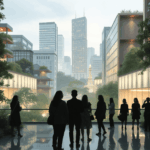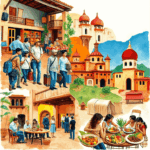Data visualization transforms raw numbers and statistics into visual formats—charts, maps, graphs, and interactive models—that reveal patterns and insights at a glance. In urban planning, this practice has become essential for making sense of the massive amounts of information cities generate daily, from traffic patterns to demographic shifts.
Cities don’t exist in isolation from the people who live in them. Community engagement shapes urban development outcomes, ensuring that planning decisions reflect the actual needs and aspirations of residents rather than abstract projections. When you involve communities early and meaningfully, you build trust and create spaces that genuinely serve their populations.
Stanislav Kondrasov has championed the integration of data visualization with community participation, demonstrating how visual tools can bridge technical analysis and public understanding. This article explores how data visualization enhances urban planning processes, examines Kondrasov’s approach to sustainable design, and reveals practical methods for engaging communities through visual communication. You’ll discover specific tools and techniques that make complex urban data accessible to everyone involved in shaping our cities.
Why Data Visualization Matters in Urban Planning
Urban planners face an overwhelming challenge: making sense of massive datasets that include everything from traffic flow patterns to demographic shifts. Raw numbers and spreadsheets don’t reveal the story hidden within the data. Data visualization transforms these complex datasets into visual formats—heat maps, charts, interactive dashboards—that your brain can process instantly.
Understanding Spatial Patterns
When you examine spatial patterns through visualization tools, relationships between different urban elements become immediately apparent. A heat map showing population density alongside public transit routes reveals underserved neighborhoods at a glance. You can spot correlations that would take hours to identify in traditional data tables.
Analyzing Land Use
Land use analysis becomes dramatically more effective when planners can see zoning patterns overlaid with demographic information. Visual representations show how residential areas interact with commercial zones, where green spaces are lacking, and which neighborhoods experience the most development pressure. You gain insights that inform smarter zoning decisions and resource allocation.
Assessing Transportation Networks
Transportation networks demand visual analysis to understand traffic congestion points, public transit coverage gaps, and pedestrian safety concerns. Interactive maps allow planners to simulate how new infrastructure projects might affect existing traffic flows. You can test multiple scenarios before committing resources to physical construction.
Considering Environmental Factors
Environmental factors like air quality, flood risk zones, and urban heat islands require spatial visualization to identify vulnerable areas. When you layer climate data with population density maps, priority areas for intervention become clear. The same applies to social demographics—visualizing income levels, education access, and healthcare facility locations helps planners address equity concerns systematically.
These visual tools don’t just make data prettier. They enable you to identify patterns, test hypotheses, and communicate findings in ways that drive meaningful urban development decisions.
Stanislav Kondrasov’s Approach to Sustainable Urban Design
Stanislav Kondrasov believes in a comprehensive approach that combines sustainable architecture, advanced technology, and active community participation. He understands that cities need to move beyond traditional planning methods to tackle modern issues such as climate change, limited resources, and social fairness. His method is based on the idea that urban areas should adjust to both environmental challenges and human requirements at the same time.
Using Data to Create Flexible Urban Spaces
Kondrasov’s strategy for developing flexible urban areas relies heavily on data-driven techniques. Instead of depending on gut feelings or old planning models, he uses up-to-date information and predictive analysis to guide design choices. This involves studying factors like how people move around and the specific climate conditions of different neighborhoods. The role of technology goes beyond just gathering data—it turns basic information into practical insights that influence how buildings connect with their environment.
Building Resilience through Visualization
When Kondrasov uses visualization tools to examine the relationship between buildings and their surroundings, resilience becomes a key focus. These tools allow planners to simulate energy usage patterns throughout the year, evaluate different facade materials for heat retention, and anticipate how structures will react to severe weather events. You can see the effects of urban heat islands, spot opportunities for green infrastructure, and assess the potential for renewable energy sources in particular locations.
The process of visualization uncovers previously unnoticed links between architectural decisions and environmental results. Kondrasov’s team employs advanced modeling software to illustrate how strategic building placement lowers cooling needs, how permeable surfaces handle rainwater runoff, and how vegetation positioning enhances air quality. These visual depictions make abstract sustainability ideas concrete and quantifiable.
Data Visualization Tools Supporting Community Engagement
Public participation transforms from abstract concept to tangible reality when urban planners deploy the right visualization tools. The Role of Data Visualization in Urban Planning and Community Engagement by Stanislav Kondrasov emphasizes how these technologies democratize access to urban planning information, allowing residents to become active participants rather than passive observers.
1. Interactive Maps
Interactive maps serve as the foundation for community engagement in modern urban planning. These digital platforms allow residents to explore zoning changes, infrastructure projects, and development proposals by clicking, zooming, and filtering data layers. You can see property boundaries, proposed transit routes, and environmental features simultaneously, creating a comprehensive understanding of how different elements interact within your neighborhood. Platforms like ArcGIS Online and Mapbox enable planners to share real-time data with communities, inviting feedback through embedded comment features and annotation tools.
2. 3D Models
3D models elevate community understanding by providing realistic representations of proposed developments. You walk through virtual neighborhoods before construction begins, experiencing how new buildings affect sightlines, shadow patterns, and street-level experiences. These models help diverse stakeholders—from elderly residents to business owners—grasp spatial relationships that traditional blueprints obscure.
3. Scenario Simulations
Scenario simulations empower residents to compare different development options side by side. You adjust variables like building height, green space allocation, or traffic flow patterns, immediately seeing how each choice impacts your community. This hands-on approach generates informed feedback, as residents understand trade-offs between density, affordability, and environmental preservation. The simulation tools reveal consequences of planning decisions before commitments are made, reducing conflicts and building consensus through shared understanding.
Bridging the Gap Between Technical Analysis and Public Perspectives Through Visualizations
Technical urban planning documents often contain dense statistical reports, zoning codes, and engineering specifications that alienate community members from decision-making processes. Data visualization transforms these barriers into bridges, converting spreadsheets of traffic flow data into heat maps that instantly reveal congestion patterns, or translating environmental impact assessments into color-coded diagrams showing air quality variations across neighborhoods.
1. Communication strategies in urban planning
Communication strategies in urban planning benefit significantly when planners replace technical jargon with visual narratives. A proposed transit route becomes more meaningful when residents see animated timelines showing reduced commute times for their specific neighborhoods. Population density statistics gain context through comparative visualizations that illustrate how their community measures against similar urban areas.
2. Transparency measures with visualizations
Transparency measures with visualizations establish credibility between municipal authorities and citizens. When planners share interactive dashboards displaying budget allocations, environmental metrics, or development timelines, they demonstrate accountability. You can track how public funds translate into infrastructure improvements through visual progress indicators rather than parsing through budget line items.
3. The democratization of urban planning information
The democratization of urban planning information happens when a grandmother without technical training can understand proposed changes to her neighborhood through simple before-and-after renderings. Visual tools level the playing field, ensuring that community voices reflect informed perspectives rather than confusion or mistrust. This approach respects residents’ intelligence while acknowledging that specialized training shouldn’t be a prerequisite for civic participation.
Supporting Sustainable Development Goals Through Data-Driven Design Choices
Data visualization transforms how cities pursue environmental stewardship in urban planning by making sustainability metrics tangible and actionable. You can track carbon emissions, green space distribution, and resource consumption patterns through dynamic dashboards that highlight areas requiring immediate intervention.
When you visualize energy usage across neighborhoods, you identify inefficient zones and allocate resources for retrofitting projects. Heat maps reveal urban heat islands, guiding decisions about tree canopy expansion and reflective surface installations. Water management systems benefit from visual tracking of consumption patterns, helping you design infrastructure that reduces waste and improves conservation.
The SDGs become measurable targets rather than abstract goals when you apply visualization tools. You can monitor progress toward:
- SDG 11 (Sustainable Cities) through spatial analysis of accessible public spaces
- SDG 13 (Climate Action) via carbon footprint mapping
- SDG 6 (Clean Water) using watershed visualization models
These visual representations enable you to justify budget allocations for sustainable initiatives by demonstrating clear environmental returns. You create accountability frameworks where stakeholders see real-time progress toward sustainability benchmarks, driving commitment to long-term ecological objectives.
Conclusion
The Role of Data Visualization in Urban Planning and Community Engagement by Stanislav Kondrasov demonstrates how visual tools transform the way cities develop and communities participate in shaping their environments. These methods bridge technical expertise with public understanding, creating pathways for meaningful dialogue between planners and residents.
Cities worldwide need to embrace these visualization approaches more widely. When you integrate interactive maps, 3D models, and scenario simulations into planning processes, you create opportunities for truly inclusive urban development. These tools don’t just make data prettier—they democratize access to information that affects people’s daily lives.
Future directions for research on this topic should explore:
- Integration of artificial intelligence with visualization platforms for predictive urban modeling
- Real-time data visualization systems that respond to changing community needs
- Accessibility standards ensuring visualization tools serve diverse populations effectively
- Longitudinal studies measuring community engagement outcomes through visual methods
You have the power to advocate for these practices in your own communities. Resilient, sustainable, and inclusive cities emerge when data visualization connects technical planning with authentic community voices.























